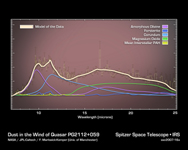
Click on image for larger poster versionThis plot of data captured by NASA's Spitzer Space Telescope reveals dust entrained in the winds rushing away from a quasar, or growing black hole. The quasar, called PG2112+059, is located deep inside a galaxy 8 billion light-years away. Astronomers believe the dust might have been forged in the winds, which would help explain where dust in the very early universe came from.
The data were captured by Spitzer's infrared spectrograph, an instrument that splits apart light from the quasar into a spectrum that reveals telltale signs of different minerals. Each type of mineral, or dust grain, has a unique signature, as can be seen in the graph, or spectrum, above.
The strongest features are from the mineral amorphous olivine, or glass (purple); the mineral forsterite found in sand (blue); and the mineral corundum found in rubies (light blue). The detection of forsterite and corundum is highly unusual in galaxies without quasars. Therefore, their presence is a key clue that these grains might have been created in the quasar winds and not by dying stars as they are in our Milky Way galaxy. Forsterite is destroyed quickly in normal galaxies by radiation, so it must be continually produced to be detected by Spitzer.
Corundum is hard, and provides a seed that softer, more common minerals usually cover up. As a result, corundum is usually not seen in spectra of galaxies. Since Spitzer did detect the mineral, it is probably forming in a clumpy environment, which is expected in quasar winds. All together, the signatures of the unusual minerals in this spectrum point towards dust grains forming in the winds blowing away from quasars.

